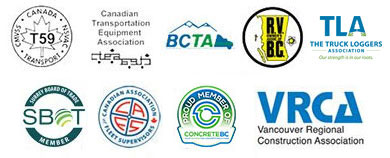It is important that you have your brakes inspected to avoid future expensive brake repair or failure. Contact VanAxle and our technicians will inspect your brake system and provide you with an estimate outlining what is required and the costs of each part and service.
In addition to all of the brake system components listed below, we work on air brakes, hydraulic brakes, and electric brakes.
Brake Failure Warning Signs
- Your vehicle pulls to one side when braking
- You hear squealing or grinding noises
- Your brake pedal pulsates up and down when pressed
- Your brake pedal feels soft and spongy
- You have to press your brake pedal almost to the floor
- Your brake warning light comes on
- Your brake pedal is low and hard to push
- You need to add brake fluid frequently
If you notice any of these conditions book your brake inspection now.
Brake Systems Repair
Of all the parts that make up your vehicle, the braking system is one of the most important. Understanding the basic principles of your brake system will help you to a more informed decision of when your brakes need servicing.
Computer-controlled ABS brakes are designed to allow you to maintain steering control, by preventing wheel lock-up during sudden braking situations or braking on severe road conditions. If your ABS/ Brake light is on your ABS may be disabled and your vehicles safety will be compromised.
More information on brake systems and components
Brake Components
Brake Pads and Shoes
Brake pad and shoe friction are available in a variety of types such as, semi-metallic and ceramic. Brake pads and shoes are forced against a rotor or drum that creates friction to slow the vehicle and are the wearable parts of your brake system that should be inspected annually.
Replacing worn brake pads and shoes before they get to the metal-to-metal will save you money. When your brake pads and shoes get to this point it usually means expensive rotor and / or drum replacement.
Brake Rotors and Drums
Brake rotors and drums are attached to the wheel of your vehicle. They are the surfaces that the brake pads and shoes are forced against when braking. Brake rotors and drums must dissipate heat and stand up to continuous contact with water and road grit.
Brake Calipers (disc brakes)
Brake calipers are large hydraulic clamps. Calipers have one or more pistons that move outward with the increased brake fluid pressure, forcing the brake pad to contact the rotor surface thereby slowing or stopping your vehicle. When you take your foot off the brake pedal it releases the pressure, the piston retracts moving the brake pad off the rotor surface.
Caliper integrity is vital to the function of the brake system and can be compromised as a result of exposure to road conditions, heat and contaminated brake fluid.
Brake Hardware
Brake hardware is what keeps brake parts in their proper location and returns them to their original location after use of braking system. Disc brakes usually include anti-rattle springs, pad-retaining springs, shims, caliper pins, support keys, return springs and retaining screws. Drum brakes usually include return, hold-down, adjuster springs and adjuster screw assembly.
When servicing your brakes it is always a good idea to have your hardware replaced, this will ensure safe braking and a longer life on your new brakes.
Brake Lines and Hoses
Brake lines and hoses send brake fluid/compressed air to various parts of the braking system.
Brake Fluid
Brake fluid is a liquid used in the brake hydraulic system. This fluid is sent to the various parts of the braking system when use the brake pedal. Brake fluid should be checked regularly, and flushed as part of a vehicles general maintenance. If you are frequently adding brake fluid to your vehicle you may have a leak in the hydraulic system, this should have inspected immediately







